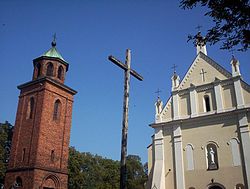| This article needs additional citations for verification. Please help improve this article by adding citations to reliable sources. Unsourced material may be challenged and removed. Find sources: "Biała Rawska" – news · newspapers · books · scholar · JSTOR (December 2014) (Learn how and when to remove this message) |
| Biała Rawska | |
|---|---|
 Church and belfry Church and belfry | |
 Coat of arms Coat of arms | |
 | |
| Coordinates: 51°48′N 20°29′E / 51.800°N 20.483°E / 51.800; 20.483 | |
| Country | |
| Voivodeship | Łódź |
| County | Rawa |
| Gmina | Biała Rawska |
| Government | |
| • Mayor | Wacław Adamczyk |
| Area | |
| • Total | 9.53 km (3.68 sq mi) |
| Population | |
| • Total | 3,081 |
| • Density | 323/km (840/sq mi) |
| Time zone | UTC+1 (CET) |
| • Summer (DST) | UTC+2 (CEST) |
| Postal code | 96-230 |
| Area code | +48 46 |
| Car plates | ERW |
| Voivodeship roads | |
| Website | http://www.bialarawska.pl/ |
Biała Rawska is a town in Rawa County, Łódź Voivodeship, Poland, with 3,081 inhabitants as of December 2021.
History
Biala Rawska is one of the oldest settlements of historic Mazovia. In the 12th century, it probably was an administrative center and the seat of a castellan, but first written document which confirms the existence of Bela, as it was called, comes from 1246. The gord of Bela was protected by a wooden rampart, as it did not have a defensive wall. The castellany of Bela was in the 14th century transferred to Rawa Mazowiecka.
It is not known when Biala Rawska received town charter, but it happened before 1498. At that time, the town was property of Bishops of Chelm, and was an important administrative center, seat of Biala County of Rawa Voivodeship. Located along busy merchant trails to Mazovian Czersk, Leczyca and Sandomierz, Biala prospered. Good times ended in the 1650s, during the disastrous Swedish invasion of Poland, after which the population of Biala was reduced to only 100 people. The town never recovered from Swedish destruction: in 1777, its population was only 186.
In 1870, following January Uprising, Biala lost its town charter, recovering it in 1925. In 1900, the population was over 2,000, with a significant Jewish element. In 1921, Biala's population was 2328, with 38% Poles and 61% Jews.
During World War II, Biala lost 1,800 people. That includes almost all of the approximately 1200 Jews who lived there in 1939. During the war, the Jews were persecuted and robbed; in 1941 the Jewish populace was forced to live in a ghetto. Six or seven families shared each room and as a consequence there were epidemics of typhus and other diseases. Around ten people a day died in the ghetto. In August 1942, German and Polish police surrounded the ghetto and forced Jews into trains destined for Treblinka. At Treblinka, all were murdered immediately by gassing. Only a handful of Biala Rawska's Jews survived the Holocaust.
Notable residents
- Mariusz Pudzianowski (born 1977), strongman and mixed martial artist, 5-time winner of World's Strongest Man title
Gallery
References
- "Burmistrz Białej Rawskiej". bip.bialarawska.pl (in Polish). Bulletin of Public Information of Gmina Biała Rawska. Retrieved 2022-09-03.
- "Local Data Bank". Statistics Poland. Retrieved 2022-09-03. Category K1, group G441, subgroup P1410. Data for territorial unit 1013024.
- ^ "Local Data Bank". Statistics Poland. Retrieved 2022-09-03. Category K3, group G7, subgroup P1336. Data for territorial unit 1013024.
- "Local Data Bank". Statistics Poland. Retrieved 2022-09-03. Category K3, group G7, subgroup P2425. Data for territorial unit 1013024.
- Megargee, Geoffrey (2012). Encyclopedia of Camps and Ghettos. Bloomington, Indiana: University of Indiana Press. p. Volume II 198–199. ISBN 978-0-253-35599-7.
External links
- Official website (in Polish)




